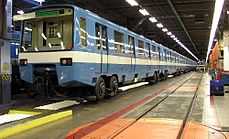MR-63
| MR-63 | |
|---|---|
|
An MR-63 train housed at Beaugrand Garage, June 2004 | |
|
Refurbished interior of an MR-63 train at Honoré-Beaugrand station | |
| In service | 1966–present |
| Manufacturer | Canadian Vickers |
| Constructed | 1965–1967 |
| Refurbishment | GEC Alsthom (1993) |
| Number built | 336 vehicles (112 sets in 3-car formation, 37 sets + 3 surplus cars in 9-car formation) |
| Formation | 6 and 9 cars per trainset |
| Capacity | 160 passengers per car, 39-40 passengers seated (1440 passengers in complete 9-car set) |
| Operator | Société de transport de Montréal |
| Depot(s) | Angrignon, Beaugrand |
| Line(s) served |
Green Line, Yellow Line |
| Specifications | |
| Car body construction | Lightweight steel alloy |
| Width | 2.5 m (8 ft 2.4 in) |
| Doors | 4 pairs per side |
| Maximum speed | 70–72 km/h (43.5–44.7 mph) |
| Weight | 26,080 kg (57,500 lb) per car (unladen) |
| Traction system | 360-V series rheostatic traction motors, Canron-Jeumont chopper (single prototype trainset fitted in the early 1970s) |
| Power output | 113 kW (152 hp) |
| Acceleration | 4.8 km/h/s or 3.0 mph/s |
| Power supply | 750-volt DC third rail |
| Bogies | 2 sets per car |
| Braking system(s) | Electromagnetic brakes using wooden brake shoes |
| Safety system(s) | ATC (ATO) |
| Track gauge | 1,435 mm (4 ft 8 1⁄2 in) |
The MR-63 is the first and oldest EMU rapid transit train type operated on the Montreal Metro in the city of Montréal, Québec, Canada.
Based on the Paris Métro's MP 59 rolling stock, the MR-63 were constructed by Canadian Vickers from 1965–1967 and was introduced on October 14, 1966 on the opening of the Montreal Metro, and are still in service. During this time the fleet has undergone numerous technological and reliability upgrades, starting with the introduction of Automatic Train Control in 1976 (with subsequent revisions of hardware and software), major refurbishments of the MR-63 coaches by GEC Alsthom at Pointe St. Charles workshops in 1993, solid-state door interlocks in 2003, modern ergonomic driver cabs with new digital dashboards, and automatic station announcements in 2005 (voiced by Michèle Deslauriers).
The MR-63 is identified with grey interiors, four ventilation hoods protruding over the roof of each car, two 113 kW (152 hp) 360-V series traction motors that make a whining noise, and round cab headlights. Montreal's rolling stock is among the oldest still in use on any metro system in the world. In the early 1970s, one 9-car trainset, consisting of three trains in 3-car formation, had their traction systems replaced with a prototype for a chopper traction system manufactured by the Canron company using a Jeumont original design. Trains utilizing the current chopper system produce an unusually loud 5-tone chorus as the train begins its initial acceleration out of the station. The frequencies used (90 Hz, 120 Hz, 180 Hz, 240 Hz, and 360 Hz) just so happen to produce a musically appealing sound that was later incorporated, by popular demand, into the 3-tone door closing chimes of newer trains. Two of the three 3-car prototype trains are still in service (one train is much louder than the other), while the other 3-car prototype train was subsequently retired from service and is now used as part of the Just for Laughs festival.[1]
Maintenance of Montreal's subway cars is rigorous, as reliability levels (Mean Distance Between Failures/MDBF ratings) are more than double that of typical North American subway cars by North American standards (at 200,000 km or 124,300 mi in 2004). However, they suffer elevated levels of vandalism, they retain many obsolete components, parts availability is diminishing, and ride quality has deteriorated over the years as their suspension systems and rubber spring packs harden with old age. Poor ride quality has not been attributed to the tires or tracks.
The MR-63 model uses a series-to-parallel servo camshaft rheostat to control and regulate power to its traction motors; this control system can be heard tapping under the floor of a motor car as the train undergoes rapid acceleration at an initial rate of 1.33 m/s2 (4.4 ft/s2) (4.8 km/(h·s) or 3.0 mph/s). This control system also features a dynamic rheostatic braking mode that uses the motors to slow the train, turning the motors into generators and dissipating the resulting energy as heat in the rheostat grid.
The MR-63 trains are expected to be retired starting from 2015 with the introduction of the MPM-10 trains, and the last MR-63 trains are to be retired by 2017.
See also
- List of driverless trains
References
- ↑ http://www.logiquefloue.ca/metro/train-jeumont/station-chantilly/. Retrieved 2013-02-14.
